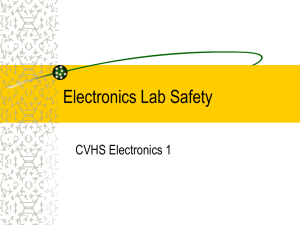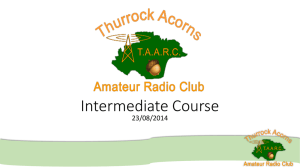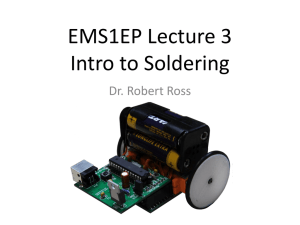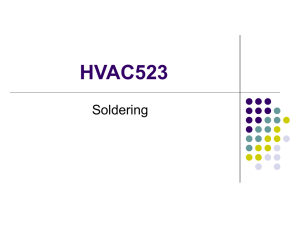GAME-101 Soldering Overview
advertisement
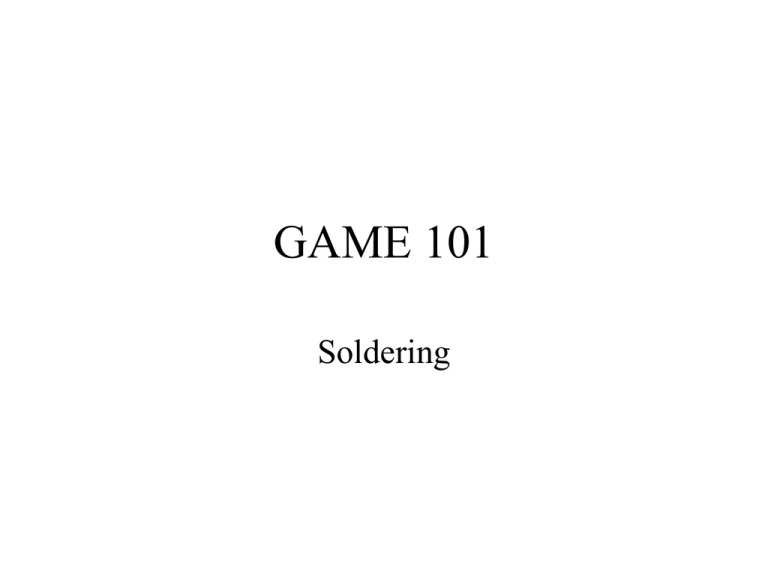
GAME 101 Soldering Soldering Introduction • As the electronics industry matures in its technology the methods of soldering required for this technology has improved. • Soldering is considered a scientific skill that has to be taught to the technician/student and then continually practiced. Soldering Intro • Engineers and technicians have found that many failures that were attributed originally to faulty components were actually the fault of poorly soldered interconnections. • Many studies have been done in the past to determine what makes a good, strong and reliable soldered connection. • Decreased unit weight and increased reliability are just two of the gains made from these studies. Soldering Intro • In today’s Armed Forces and in Industry, the initial high cost of purchasing sophisticated equipments severely limits the size of the buy and the numbers of spares held "on shelf". • Therefore, unplanned break-downs or failures are costly; in time, money, delays or even lives. • This is a cost too great to be taken lightly. Soldering Intro • Technicians must insure in all stages of initial build, rework, modification or repair, that sharp attention is paid to the making of a strong and reliable soldered connection and that all repairs are carried out to high standards. Fluxes • Flux has other functions besides aiding the flow of solder. • One primary function is the removal of tarnishes (light surface oxides). • Under normal, everyday conditions both the surfaces to be soldered and the solder itself have a thin film of tarnish on their surfaces. This film, which is made of oxides, sulphides, carbonates and other corrosion producers, act as a barrier interfering with the flow of solder. • These tarnishes must be removed! Flux • When the flux is initially applied, the flux displaces the gaseous layer from the metals surface; • When the flux is then heated, the flux reacts chemically with the tarnish, most often combining to form a third compound which is either soluble in the flux or can be carried away by the flux. This then exposes a clean metal surface to the incoming solder. NOTE:It is important to realize that these tarnishes cannot be cleaned with any conventional solvent nor treated and removed like a grease. • The actual chemical reaction is one of corrosion. In the flux's passive or raw state it should be non-conductive and non-corrosive. Flux • When activated by heat, at slightly lower than soldering temperature, the flux becomes very corrosive. • This insures a rapid rate of tarnish/oxide removal. NOTE: Once the heat source is removed, the flux cools down but still remains mildly corrosive. Also since there are many impurities in the flux residue, it is now somewhat conductive. Therefore, it is mandatory that cleaning is carried out after the soldering operation is complete. Solder • Today, as long ago, solder is made by combining varying proportions of tin and lead. • The most unique fact about this alloying is that the hybrid alloy has a melting point always lower than that of either the tin or lead alone. • With most solder ratios, the melting point is not sharply defined. It begins to melt at one temperature but is not completely melted until a higher temperature is reached. Plastic State • This intermediate stage is called the plastic range or state. • In this state the solder is neither a metal nor completely liquid. • The duration of the plastic range depends on the ratio of solder elements being used. Plastic range of 60/40 solder: melt begins at 361 degrees F and is complete at 375 degrees F. Solder Connection • The actual solder joint is constructed only when the solder is in the molten (liquid) state. • When molten, the solder acts as a metal solvent. • As it flows across the work piece, it dissolves a tiny layer of the metal. • This is called an intermetallic solution action or intermetallic bonding. • The solder dissolves and penetrates the metal's surface with the molecules of both the solder and metal combining to form a new metallic alloy (SN6CU5). • This bonding provides a continuous and permanent bond that is also electrically constant. Bonding / Wetting Action • The degree or amount o£ bonding depends on how much surface area is covered, or how well the solder flows over the surface. This action is called Wetting Action. • Good wetting action can only occur when the solder and work surface are at the proper temperature and the work surface is free from contamination. Molten solder dissolves and penetrates a clean copper surface, forming an intermetallic bond. To insure proper wetting, the surface must be pre-cleaned. Remove grease and oils with solvents; Remove heavy oxides by abrading and pre-tinning; and Flux component leads to prevent reoxidation.s Dihedral Angle (Elevation) • A visible indication whether or not a soldered connection has the proper amount of wetting is the dihedral angle. • Dihedral is a term used to describe a positive or upward elevation, like some aircraft wings. • In soldering we use it to measure wetting action. • A connection with a low dihedral angle is considered to be the proper result of good cleaning and wetting. • In the figure below you can see on the left aide of the component lead a very small dihedral angle, less than 5 degrees. The right side has a far greater dihedral angle. Dihedral Angle The preferred dihedral angle must be less than 30 degrees, although standards of acceptability will allow for dihedrals up to 60 degrees. In any case anything over 60 degrees is unacceptable. Soldering • Correct soldering requires care, experience and total attention to ensure high quality results. • It cannot be over-emphasized just how important maintaining high soldering standards is. • With today’s greatly improved technology, the individual component failure rate has been reduced to a point where faulty solder joint represents a significant percentage of total failures. Soldering Steps The actual soldering process requires the use of heat for three reasons: a. to activate flux and convert solder to a liquid; b. to decrease surface tension; and c. to cause inter-metallic bonding to take place. Contrary to popular thought, the real problem in soldering is not controlling tip temperature but in controlling the heat cycle of the work... how fast the work gets hot .... how hot it gets... and how long it stays hot. Three Factors that must be Considered when Soldering • relative thermal mass, • surface condition of the joint and • thermal linkage. Surface Condition of the Joint • If there are any oxides or contaminants covering the pads or leads there will then be a barrier/blockage to the flow of heat between the pad/lead and iron tip. The end result being, the tip is unable to supply enough heat to melt the solder. • To make a good solder joint, the surface must be clean!!! • Before attempting to solder, clean the joint with a solvent, such as Freon TF, to remove greases and other films. Then use a fine-abrasive to remove the surface oxides. • NOTE: Do not use an abrasive on gold plated leads as the base metal may not be solderable. The Technician’s Job How can the technician tell when there is too much or too-little-heat being applied to the workplace? We use the (W.P.I.) Work Piece Indicator which is defined as: • The reaction of the workpiece to the work actions being performed on it, and are discernible to the human senses of SIGHT, TOUCH, SMELL, and SOUND. Work Piece Indicators • In other words, we use a method of observation using your senses while performing an action. Then seeing the effect and modifying your action as a result of the effect. • Work can be viewed as a closed-loop system; feed-back comes from the reaction of the workpiece and is used to modify the action. Workpiece Indicators - changes discernible to the human senses - are the way "the work talks back to you" Workpiece Indicators Soldering and De-soldering • For soldering and de-soldering the most important workpiece indicator is heat rate recognition. In other words, observing the rate at which the entire solder joint melts. This rate is determined by: a. capacity of the iron; b. surface condition of the tip; c. thermal linkage between tip and workpiece; d. surface condition of the work piece; and e. relative thermal mass of tip and workpiece. Workpiece Indicators • Another workpiece indicator is the change in workpiece colour and brightness although this W.P.I. is used more at a later stage. Soldering Iron • When applying the soldering iron to the workpiece, the tip should be applied to the point of maximum mass. • The tip must make maximum contact at this point to ensure a rapid rate of temperature elevation to the soldering temperature. • This is done by building a heat bridge. This would help to lessen the chance of heat damage to heatsensitive components. Soldering Iron • Before applying solder to the joint, the temperature of the workpiece must be higher than the solder's melting point. • When this is done and the workpiece is properly cleaned and fluxed, the solder will melt and flow without direct contact to the iron, resulting in a smooth, even surface that feathers out at the edge (low dihedral angle). • Do not apply the solder to the soldering iron tip and allow it to flow to the cooler workpiece surface as this will result in an improperly wetted joint or spikes. CONSTRUCTION OF THE SOLDER JOINT • Before the actual soldering is to take place, let's look at what makes a soldered connection acceptable or not. • Acceptable solder joints should consist of a well feathered, shiny, continuous fillet without gap or fracture, with the two soldered surfaces plainly visible through the fillet. A good solder joint - is clean - is bright - is shiny - has a concave fillet - has good wetting An unacceptable solder joint can be: - pregnant - lean - pitted - spiked - outgassed - frosty - fractured - balled (solder balls) - re-melted - has poor wetting - has copper showing SINGLE STEP METHOD a. b. c. d. Remove all greases/grimes with a suitable solvent. Remove any heavy oxides/tarnishes by abrasive means. Clean all abrading residues with a suitable solvent. Flux all exposed areas and work surfaces (controls new oxide build-up) when working with wire leads; flux and pre-tin. e. Ensure soldering iron is at correct operating temperature, f. Clean tip and thermal shock the tip to remove oxides. g. Place tip at point of maximum mass and build a heat bridge. h. Remove solder and allow joint to heat. i. Place solder farthest away from heat source (usually opposite to the iron or on top of the lead). j. Remove solder. k. Remove iron. l. Thoroughly clean all flux residues and cleaning agent residues from workpiece. m. Check for acceptability of finished joint. NOTE: Total dwell time should not exceed 3 sec for discrete components and 2 sec for semi-conductor devices!!

